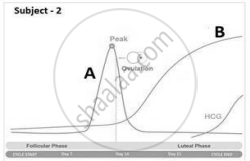Advertisements
Advertisements
Question
During the reproductive cycle of a human female, when, where and how does a placenta develop? What is the function of placenta during pregnancy and embryo development?
Solution
During the reproductive cycle of human female, placenta develops after the implantation of zygote in the uterus.
1) Nutrition : It helps to transport nutrients from mother's blood to foetus for its development.
2) Respiration: It provides oxygen to the foetus and take CO2 away from the foetus.
3) Excretion: It helps in the removal of waste products from the foetus and transfers them to mother's blood.
4) Immunity: It provides immunity to the foetus. Antibodies developed in mother's blood passes onto the foetus through the placenta.
5) Storage: It stores some fats, glycogen and iron.
6) Secretion of hormones: It secretes many hormones like oestrogen, progesterone, gonadotropin and placental lactogen.
APPEARS IN
RELATED QUESTIONS
When and where do chorionic villi appear in humans?
Comment on the role of placenta as an endocrine gland.
Mention any two functions of the human placenta.
The first movements of the foetus and appearance of hair on its head are usually observed during which month of pregnancy?
Which of the following hormones is not a secretory product of human placenta?
To answer the question, study the graphs below for Subjects 1 and 2 showing different levels of certain hormones.


Subject 2 has a higher level of hormone B, which is ______
Placenta is
Assertion: Functional ADA cDNA genes must be inserted in the lymphocytes at the early embryonic stage.
Reason: Cells in the embryonic stage are mortal, differentiated and easy to manipulate.
Explain the formation of placenta after the implantation in a human female.
Name the type of antibody that can be transferred through the placenta.
